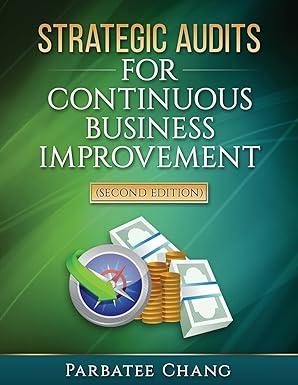Question
This is for Comprehensive problem 5 for Accounting warren reeve 24th edition i really need the help. thanks. Performance Evaluation Using Variances from Standard Costs:
This is for Comprehensive problem 5 for Accounting warren reeve 24th edition i really need the help. thanks.
Performance Evaluation Using Variances from Standard Costs: Comprehensive Problem 5
Natural Fragrance, Inc., began operations on January 1, 2012. The company produces a hand and body lotion in an eight-ounce bottle called Eternal Beauty. The lotion is sold wholesale in 12-bottle cases for $80 per case. There is a selling commission of $16 per case. The January direct materials, direct labor, and factory overhead costs are as follows:
Performance Evaluation Using Variances from Standard Costs: Comprehensive Problem 5
View PDF Part A and Break-Even Analysis
The management of Natural Fragrance, Inc., wishes to determine the number of cases required to break even per month. The utilities cost, which is part of factory overhead, is a mixed cost. The following information was gathered from the first six months of operation regarding this cost: 2012 Case Production Utility Total Cost January 300 $230 February 600 263 March 1,000 300 April 900 292 May 750 280 June 825 285
View PDF Instructions
2. $46.98
Determine the fixed and variable portion of the utility cost using the high-low method. Determine the contribution margin per case. Determine the fixed costs per month, including the utility fixed cost from part (1). Determine the break-even number of cases per month.
Part B and August Budgets
During July of the current year, the management of Natural Fragrance, Inc., asked the controller to prepare August manufacturing and income statement budgets. Demand was expected to be 1,300 cases at $80 per case for August. Inventory planning information is provided as follows: Back to Top [View PDF] P. 1096 [Click here to add Bookmark]
Finished Goods Inventory: Cases Cost Estimated finished goods inventory, August 1, 2012 200 $6,000 Desired finished goods inventory, August 31, 2012 100 3,000
View PDF
Materials Inventory: Cream Base (ozs.) Oils (ozs.) Bottles (bottles) Estimated materials inventory, August 1, 2012 200 240 500 Desired materials inventory, August 31, 2012 800 300 200
View PDF
There was negligible work in process inventory assumed for either the beginning or end of the month; thus, none was assumed. In addition, there was no change in the cost per unit or estimated units per case operating data from January. Instructions
6. Bottles purchased, $5,640
5. Prepare the August production budget.
6. Prepare the August direct materials purchases budget.
7. Prepare the August direct labor budget.
8. Prepare the August factory overhead budget.
9. Prepare the August budgeted income statement, including selling expenses. Part C and August Variance Analysis
During September of the current year, the controller was asked to perform variance analyses for August. The January operating data provided the standard prices, rates, times, and quantities per case. There were 1,300 actual cases produced during August, which was 100 more cases than planned at the beginning of the month. Actual data for August were as follows: Actual Direct Materials Price per Unit Actual Direct Materials Quantity per Case Cream base $0.014 per oz. 74 ozs. Natural oils $0.27 per oz. 26 ozs. Bottle (8-oz.) $0.35 per bottle 12.6 bottles Actual Direct Labor Rate Actual Direct Labor Rate Time per Case Mixing $15.20 16.20 min. Filling 11.70 4.80 min. Actual variable overhead $162.00 Normal volume 1,350 cases
View PDF
The prices of the materials were different than standard due to fluctuations in market prices. The standard quantity of materials used per case was an ideal standard. The Mixing Department used a higher grade labor classification during the month, thus causing the actual labor rate to exceed standard. The Filling Department used a lower grade labor classification during the month, thus causing the actual labor rate to be less than standard.
Instructions
11. Mixing time variance,$195 F
12. $32 U
10. Determine and interpret the direct materials price and quantity variances for the three materials.
11. Determine and interpret the direct labor rate and time variances for the two departments.
12. Determine and interpret the factory overhead controllable variance.
13. Determine and interpret the factory overhead volume variance.
14. Why are the standard direct labor and direct materials costs in the calculations for parts (10) and (11) based on the actual 1,300-case production volume rather than the planned 1,200 cases of production used in the budgets for parts (6) and (7)?
Step by Step Solution
There are 3 Steps involved in it
Step: 1

Get Instant Access to Expert-Tailored Solutions
See step-by-step solutions with expert insights and AI powered tools for academic success
Step: 2

Step: 3

Ace Your Homework with AI
Get the answers you need in no time with our AI-driven, step-by-step assistance
Get Started


